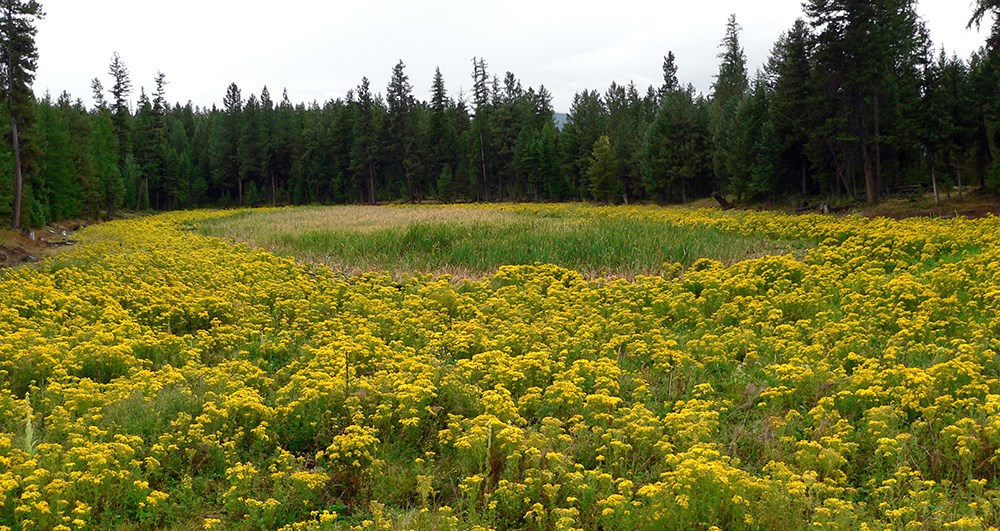Last updated: May 6, 2024
Lesson Plan
Invasive Species

Tansy ragwort is an example of a species that is pretty but destructive.
NPS photo 2015
- Grade Level:
- Lower Elementary: Pre-Kindergarten through Second Grade
- Subject:
- Science
- Lesson Duration:
- 60 Minutes
- State Standards:
- Hawai‘i Content and Performance Standards III:
SC.K.1.2, SS.K.5.2, SS.2.3.1, SS.2.7.4, SC.2.8.2 - Additional Standards:
- Next Generation Science Standards:
2-LS4-1 - Thinking Skills:
- Understanding: Understand the main idea of material heard, viewed, or read. Interpret or summarize the ideas in own words. Analyzing: Break down a concept or idea into parts and show the relationships among the parts. Evaluating: Make informed judgements about the value of ideas or materials. Use standards and criteria to support opinions and views.
Essential Question
What is an organism’s job in its habitat?
What is the difference between native and non-native species?
Objective
At the end of this lesson, the students will be able to:
1. Determine an organism’s job in its habitat and describe how they depend on each other.
2. Understand the difference between native and non-native species.
3. Determine how Haleakalā National Park protects special native habitats and how the students can help protect them too.
Background
Invasive species can be plants, animals, insects, or microorganisms, such as bacteria, fungi, and diseases. Invasive species affect every habitat in the Hawaiian Islands, from the regions deep underwater to the summit of the tallest mountains. Biologists consider invasive species the number one threat to native Hawaiian habitats.
Currently, invasive species in Hawai‘i are managed by a number of state, federal, and private agencies. Organizations such as the National Park Service, the U.S. Department of Agriculture, the Hawai‘i Department of Land and Natural Resources, The Nature Conservancy, and the invasive species committees and watershed partnerships on each island make it their mission to prevent harmful alien species from spreading throughout the Islands.
Preparation
Materials Needed:
Invasive Species List (included)
Poster Paper
Coloring supplies
Materials
Four invasive species on list: Coqui frog, Miconia, Little fire ant, and Vespula wasp. Includes a contact number to call if invasive species are seen.
Download Invasive Species List
Lesson Hook/Preview
Procedure
Step 1: Introduction
- Review definitions of native and non-native.
o Non-native = Plants and animals that are brought to an area by people, either on purpose or accidently.
- Define Invasive species = Non-native species that compete with native species for valuable homes and food in their habitats.
- Show students the Invasive Species List using ELMO or make copies and pass the list out.
- Discuss the different types of invasive species found on the cards.
Step 2: Create a Poster
Students will create an invasive species poster about one of the species on the list. Their posters should include the following:
- The name of the invasive species.
- A hand drawn picture of the invasive species.
- Where the invasive species was originally from.
- How it is a danger to our native species and their habitats.
- What we can do and whom should we contact if we see this “criminal”.
Step 3: Share Posters and Journal activity
Share posters and discuss the negative impact invasive species have on native species and their habitats. Journal the following questions:
- What would happen to the native species of Haleakalā National Park if it got invaded by any of these invasive species?
- How does Haleakalā National Park protect native species from them?
- What could you do to help stop the spread of invasive species on Maui?
Vocabulary
Invasive species: Non-native species that compete with native species for valuable space and food in their habitat.
Native: Plants and animals that got to Hawai’i by themselves, without the help of people.
Non-native: Plants and animals that are brought to an area by people, either on purpose or accidently.
Additional Resources
Boynton, D. (2000). Discover Hawaiʻi’s natural forests. Aiea, HI: Island Heritage.
Hawai’i Forest Bird Free App by National Park Service.
https://play.google.com/store/apps/details?id=com.ionicframework.hawaiiforestbirds616462
‘Ōhiʻa Project. (1989). An environmental education guidebook for Hawaiʻi. Honolulu, HI: Bernice Pauahi Bishop Museum and Moanalua Gardens Foundation.
University of Hawaiʻi at Manoa: College of Tropical Agriculture and Human Resources.
• Pulelehua Project. http://cms.ctahr.hawaii.edu/pulelehua/Home.aspx
• Coqui Frogs. http://www.ctahr.hawaii.edu/coqui/background.asp
Staples, G. W., Cowie, R. H. (2001). Hawaiʻi’s invasive species. Honolulu, HI: Bishop Museum Press.
